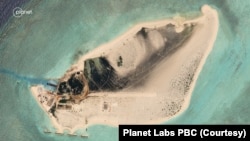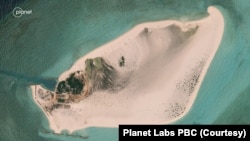Satellite images of Triton Island reveal a new structure that experts believe is a part of China's military expansion meant to support its maritime claims in the South China Sea. The images have sparked protests from the U.S., Vietnam and Taiwan.
Triton Island, part of the Paracel Islands group, has become the latest flashpoint in the disputed region.
China claims the Paracels and the nearby Spratly Islands as its own maritime territories and has been expanding its military installations on the island chains.
Vietnam and Taiwan also claim the Paracels and Spratlys as their island groups. The two countries, with the U.S., are pushing back against Beijing's maritime expansion in the region now seen by rapid construction of a new structure on Triton.
Satellite photos taken of Triton in August by Planet Labs PBC imaging service that VOA's Korean Service obtained last week show what appears to be a long runway jutting out toward the east. The structure is not visible in photos taken in March.
The structure was reported as an airstrip by the AP last week upon its analysis of satellite photos it obtained from Planet Labs PBC, which showed the Chinese red flag.
The island is approximately 4,000 feet long by 2,000 feet wide, and until recently was completely uninhabited.
According to Bill Conroy, senior maritime solutions specialist at URSA Space, which provides intelligence analysis, the structure is probably a levee as tidal waves on the island could reach as high as four feet, according to his analysis.
"That long thing that people thought was a runway is there to keep the areas dry, protected from the seawater," said Conroy in a telephone interview. "We're estimating that there's about 70,000 square meters of land that would be reclaimed from the sea" by the levee.
He added there seems to be more construction underway south of what he believes is a levee.
Another analysis by the Center for Strategic and International Studies also says the structure could be either a levee or raised roadway.
Levee, roadway or runway?
Ray Powell, director of SeaLight, a program that analyzes China's maritime gray zone tactics at Stanford University's Gordian Knot Center for National Security Innovation, said the new structure on Triton Island could be used as both a levee and roadway once completed.
Powell said via email, the structure could "make China's small military outpost there more sustainable over the long term."
Hoang Viet, an expert on South China Sea disputes at the National University of Ho Chi Minh City, said that if it is an airstrip, China could use the island as a refueling station for its aircraft during South China Sea missions "especially for long flights from Hainan to Spratly Islands."
Triton sits an equal distance between Vietnam and the Chinese island province of Hainan. It is the latest of China's permanent island remodeling projects in the South China Sea, a push that began in 2013, according to the U.S.-China Economic and Security Review Commission.
The construction now includes a scattering of permanent features like seawalls, airfields and buildings across numerous islands. Although China originally claimed the island construction projects were for scientific research, satellite imagery has revealed military infrastructure.
Whether China is building an airstrip, levee or road, experts agree that the structure on Triton would be an expansion of China's military buildup in the Paracel and Spratly island chains.
Prashanth Parameswaran, a fellow at the Wilson Center and founder of the weekly ASEAN Wonk newsletter, told VOA via email on Monday that "Individual features including [on] Triton Island will see their roles change with their capabilities."
"But the bigger picture is that these features collectively allow China to expand its presence and capabilities in the South China Sea through various ways including administration, presence, surveillance and outright coercion – with basic helipads and harbors out to large airstrips to land bombers and aircraft."
A State Department spokesperson told VOA's Korean Service on Monday that it opposes China's claims in the South China Sea and has called on Beijing to conform to international law. Due to the sensitivity of the subject, the spokesperson asked to remain anonymous.
"The United States unequivocally rejects the PRC's unlawful maritime claims and any such interference," said the spokesperson, using China's official name, the People's Republic of China.
"The PRC's reclamation and militarization of disputed outposts in the South China Sea, its willingness to use coercion and intimidation, along with other provocative actions undertaken to enforce its expansive and unlawful South China Sea maritime claims, undermine the peace and security of the region," the spokesperson said.
Relations with neighbors
The U.S. has been exercising freedom of navigation operations in the South China Sea against increasingly aggressive moves by China. The operations by U.S. naval ships and aircraft are designed to maintain peace and security in the region against what the Pentagon describes as "excessive maritime claims" by countries around the world.
The new addition on Triton Island "will likely antagonize Vietnam," according to Powell. Triton is closer to Vietnam than other Southeast Asian countries.
China has claimed 90% of the South China Sea, one of the most trafficked waters in the world, with one-third of global shipping sailing across the waters. Islets, shoals and atolls in the sea are claimed by nearly all neighboring states, including China, Taiwan, Malaysia, Brunei, the Philippines and Vietnam.
"Vietnam, being about 250 kilometers away, is the main target," said Juo-yu Lin, associate professor at the Department of Diplomacy and International Relations at Tamkang University in Taiwan.
"The Chinese People's Liberation Army can monitor Vietnam's military activities on a regular basis," Lin said via email to VOA,
At a press briefing on Thursday, Vietnamese Foreign Ministry spokesperson Pham Thu Hang said, "All activities in the Paracel Islands conducted without Vietnamese permission are violations of Vietnam's sovereignty."
"Such activities would serve to further complicate the situation and prove to be detrimental to peace, stability and security, safety, and freedom of navigation and overflight" in the region, she said.
China has fighter jets, cruise missiles, and a radar system on Woody Island, its main base in the Paracels, and a helipad on five outpost islands including Triton, Money and Pattle with Duncan Island serving as a helicopter base.
China has finished building military installations on three islands in the Spratly group to reinforce its territorial claims in the sea as well as to support its ambition to achieve a "peaceful reunification" with Taiwan, a self-governing island it considers its own.
An unnamed Taiwanese Foreign Ministry spokesperson told Taiwan News on Monday that Taipei's "rights over land and related waters in the area cannot be questioned."
Chinese Foreign Ministry spokesperson Wang Wenbin said at a news briefing on Monday that "China has indisputable sovereignty over the Nanhai Zhudao" and "the adjacent waters."
The Nahhai Zhudao refers to island groups in the South China Sea including the Pratas, Paracel and Spratly islands.
"China's construction on its own territory and China Coast Guard's action to protect China's rights and enforce the laws in waters under China's jurisdiction are legitimate, lawful and beyond reproach," Wang said.
Le Nguyen contributed to this report from Washington, and Kelly Tang contributed from Taipei.









